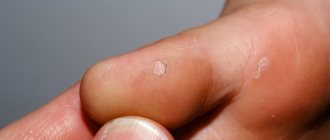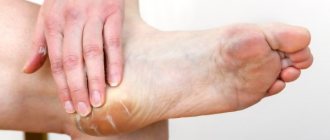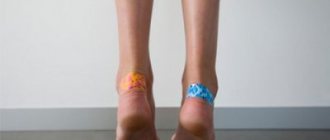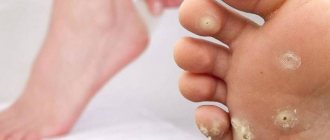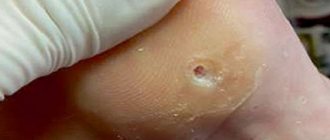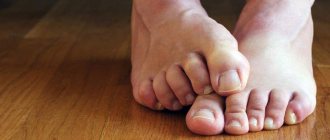Home therapy
Subungual callus can be treated independently using pharmaceutical remedies or traditional methods. It is not so easy to radically get rid of it, given that there is a barrier in the form of a nail. But with home therapy you can relieve unpleasant symptoms.
Pharmacy drugs
The pharmaceutical industry offers many creams based on herbal ingredients that soften, soothe the skin of the feet and help reduce pain.
To relieve pain, you can use the drug Collomac. The product should be applied twice a day strictly to the affected nail. The medicine should not touch healthy tissue - it can cause a burn. Contraindicated for use in the treatment of the following groups of patients:
- children under 1 year old,
- people with kidney diseases,
- having hypersensitivity to the drug.
If they come into contact with healthy skin, surrounding tissues can cause irritation, so many doctors do not recommend the use of patches for this type of callus.
Folk remedies
At home, hot or cold baths are used to alleviate the condition:
- Dissolve 3 teaspoons of baking soda and 1 teaspoon of soap in 3 liters of hot water. The feet are placed in the liquid for 30 minutes. After this, the nail softens and the painful symptoms subside.
- Dissolve 1 tablespoon of salt in 1 liter of warm water. Place your foot in the bath for 30 minutes. The product helps eliminate pain, burning, and swelling in the finger. After the procedure, the skin should be moisturized with cream.
- Add the juice of 1 lemon to 3 liters of hot water. Place your feet in the bath for 20-30 minutes. After the procedure, you can additionally apply lemon juice to the nail plate and lubricate it with moisturizer.
Various compresses and oils are also popular among home medicine:
- Place a slice of raw potato on your nail, wrap it in film and leave overnight. The root vegetable softens the plate well and temporarily relieves unpleasant symptoms.
- Flaxseed, olive, corn, castor oil have a positive effect: they soften the skin. You need to apply a couple of drops to the nail plate and wrap it in film overnight. For the best effect, the procedure should be performed every day.
- Cut a fresh onion and apply it to the nail, seal tightly and leave overnight. In the morning, rinse with water.
The disease can be cured with medication only at the beginning of the keratinization process, while the callus is only slightly noticeable, and the unpleasant sensations have not developed into pain. Necessary measures include changing shoes to more comfortable ones, softening creams and herbal baths.
If the moment is missed, therapeutic pharmaceutical drugs can only temporarily relieve the pain. For this purpose, Collomak is used in the form of drops. It must be used with extreme caution, as it is aggressive towards living skin. Used as prescribed by a doctor. Twice a day, the liquid is applied to the keratinized area, being limited to it as precisely as possible.
An alternative to drops are callus patches that are similar in action (Salipod, URGO, Gehwol). They are less comfortable because they are noticeable and can cause discomfort when putting on shoes. However, their action is less aggressive, and therefore they are considered safer and can be used without specialist advice.
To eliminate pain, you can use the pharmaceutical drug "Collomac". It contains salicylic acid, which effectively softens dead skin. It is enough to drop 10 ml 1-2 times a day. medicine on the callus area, and after 4 days the skin will soften. But it must be used carefully: the composition should not come into contact with living skin.
Doctors do not recommend using anti-corn patches. The acid they contain corrodes not only the keratinized area of the skin, but also living tissue.
A popular medication is Collomac gel. It is intended for the treatment of foot fungus, but also shows excellent results in removing subungual calluses. To do this, you need to put the gel in the subungual space 2 times a day. Due to the exfoliating effect of salicylic acid, rapid relief of the condition is achieved, and the neoplasm itself quickly decreases in size.
Causes
Every person encounters calluses in life.
Most often we are talking about ordinary calluses that appear as a result of prolonged friction. But a more rare problem is subungual callus. This is the name of a formation that occurs on the toes and brings a lot of discomfort during movement, pressing on the nail plate and soft tissues of the toe. Anyone can develop a subungual callus.
The first most common cause of the appearance of any callus, including subungual calluses, on the feet.
Having chosen tight or uncomfortable shoes, a person hopes that over time they will “break in” and become looser as they wear them, but most often this does not happen.
And, if this happens, the very process of breaking it in can bring with it not only comfortable and already suitable shoes, but also calluses or foot deformation (which will be discussed later).
The second most common reason. And this is not just a matter of too long nails, which cause too much pressure on the soft tissues of the finger and thereby contribute to the formation of calluses. Another fairly common mistake is cutting the nail plate too short during a pedicure.
In this case, the nail exposes the soft tissues and does not protect them from pressure, thereby causing the same effect as from too long nails. The problem may also lie in an incorrect cut, which is traumatic for the tissues under and around the nail.
Foot deformity
The cause already touched upon is foot deformity. It can be congenital, or it can be acquired during life.
This point includes deformations that affect the formation of calluses on the toes, including: various protruding bones, growths of hardened skin, incorrect foot placement (improper position of the toes) and curvature of the nail plate. These cases increase friction between the nail plate and the shoe, resulting in a callus on the foot.
The right shoes will help prevent foot deformities
Treatment of subungual callus is best done on an outpatient basis, after consulting a doctor. The radical method of the phenomenon is surgical intervention. This procedure can be performed in a cosmetology (beauty salon) or hospital under the supervision of a doctor.
Removing the formation on your own is strictly prohibited, because the blood vessels on the legs are located quite close to the skin and the risk of damaging them is too great. In addition, when removing it on your own, a person does not have enough tools, as well as disinfectants and antiseptics.
Read more about the stages of removing a callus on the toe:
- At the first stage, the doctor or cosmetologist takes measurements to determine the size of the callus and drills a hole in the nail above its location equal to the size of the callus.
- At the second stage, the keratinized skin under the nail is easily pierced with a drill until the patient feels slight pain, after which, instead of a puncture, a special agent is poured in that corrodes the keratinized tissue.
- After the tissues have healed, the specialist cuts through the nail and cleans out the remaining callus, and the integrity of the plate is then restored with special pharmaceutical preparations.
Medicine does not stand still, and quite recently another way to remove calluses on the foot has appeared - the use of a diamond bur. In this case, the nail remains intact; it is only slightly lifted and the keratinized tissue is cleaned out. But this procedure is expensive and not yet widespread.
Only a cosmetologist can remove a subungual callus.
Most often the question arises of how to remove the growth yourself and whether it can be done. At an advanced stage, of course, it is better to turn to specialists, but at the formation stage you can use preventive and folk remedies to remove the emerging callus.
If we talk about pharmaceuticals, the most effective way is to use Kolomak. This drug actively softens keratinized areas and helps eliminate calluses.
In addition, in modern pharmaceuticals there are many different in price and composition of creams based on medicinal plants. They also perform well in the fight against calluses. Doctors do not recommend using plasters for calluses, because they contain acids that corrode not only damaged tissue areas, but also completely healthy ones, thereby harming the body.
Anyone can develop a callus under their toenail. This can only be prevented by regular prevention. In order to avoid getting a callus on your big toe or little toe, follow a number of recommendations:
- you should choose only comfortable and comfortable shoes of the appropriate size;
- pedicure should be neat and thorough;
- any areas of keratinized skin (corns, etc.) must be removed regularly;
- thoroughly moisturize the skin of the feet with creams and other products;
- use silicone pads to prevent foot rubbing.
Conclusion
By following these tips, a person reduces the risk of subungual callus formation to a minimum. In addition, these recommendations have a beneficial effect not only on the skin of the feet, but also on the general well-being and functioning of the entire body, because a large number of nerve endings are accumulated under the skin of the feet. Take care of your feet and be healthy!
Subungual calluses are quite common, and most often they affect the outer toes - the big or little toe.
The appearance of a callus causes significant inconvenience to its owners, limiting movement and causing pain.
In the absence of any treatment, there is a possibility that the bladder will grow to the very periosteum, which can cause pain even at rest.
How to remove subungual callus?
A callus under the nail is a rather unpleasant pathological process that occurs when shoes are worn incorrectly. When a callus appears, a person experiences not only inconvenience, but also pain.
A subungual callus is a growth that appears under the nail plate. When a growth appears under the nail, severe discomfort and pain are observed. Some patients may experience blue discoloration of the nail.
The development of subungual callus can be diagnosed due to the influence of several negative factors:
- Uncomfortable shoes. Frequently wearing excessively tight shoes increases the load on the toe. If there is excessive pressure on the nails, the development of a subungual callus is diagnosed.
- Foot deformity. This pathological condition can be hereditary or acquired.
- Incorrect length of nails. With excessively short or long nails, there is pressure on the soft tissues, which leads to chafing.
The causes of the pathology may lie in a person’s poor lifestyle or concomitant diseases.
Pharmacy treatment
In the modern pharmacy network there is a huge number of products that are used to treat subungual callus. Their use should be carried out after water procedures, which will reduce the intensity of pain and also speed up the process of treating pathology.
We suggest that you familiarize yourself with the sternocleidomastoid muscles of the neck in a child.
The preparation is produced in the form of drops, which allows it to cure calluses and fungal diseases.
Painful sensations and constant discomfort become companions when a subungual callus appears on the foot. Not to mention the fact that the foot looks unaesthetic. Getting rid of calluses is extremely difficult; treatment requires effort and intervention from a specialist. But the reasons for the appearance of such formations are banal, and preventing trouble is not difficult.
A callus is an area of keratinized epithelium that has been layered for a long time rather than peeled off. The problem can affect any area of the nail and causes a lot of discomfort when walking.
A callus begins with a small bubble, which is familiar to everyone who puts new, unworn shoes on their feet. If you do not pay attention to the pain and continue to wear narrow, tight-to-wear shoes, under constant pressure, active layering begins, going through several stages.
Calluses on the skin appear as a result of dense and frequent friction against hard surfaces. If such a formation appears on the feet, then this clearly indicates tight or poor-quality shoes.
The callus gives its owner not only discomfort when walking, but also pain, and such a pathology as a subungual callus is truly a real torture.
The toes seem to become stiff when walking, causing severe unbearable pain.
Reasons for appearance
The main reasons for the appearance of calluses under the toenail are as follows:
- Acquired as a result of injury or hereditary deformation of the foot. In this case, a small bone forms on the big toe near the nail, which over time becomes covered with keratinized layers of tissue. Such formations, when in contact with objects, cause severe pain in a person.
- Tight or uncomfortable shoes. A callus in the area of the nail plate appears when the little finger or big toe is clenched during movement. Frequent use of such shoes leads to rapid hardening of the tissue under the nail.
- Poor foot hygiene. This applies to those people who cut their nails too short, or, conversely, leave the nail plate too long. When walking, the nail puts pressure on the soft tissues of the toes and forms a nail callus.
In any of these cases, the cause of the pathology is uncomfortable or too narrow shoes.
As such, a complete cure for subungual callus without the intervention of a specialist will not be possible, but you may be able to relieve yourself of pain.
A callus under your toenail will no longer cause you discomfort if you take a bath based on a decoction of chamomile, linden and string (proportion 2:2:1, respectively).
After brewing a mixture of these herbs and letting them brew, be sure to add 2-3 tablespoons of baking soda to the bath. It is used to soften the growth and soothe the pain.
- Wearing tight shoes
- Improper care of the nail plate,
- Deformation of the toenail.
- Wearing comfortable, quality shoes,
- Proper foot care
- Using cream to moisturize the skin of the feet.
- Wearing tight shoes;
- Improper care of the nail plate;
- Deformation of the toenail.
- Wearing comfortable, high-quality shoes;
- Proper foot care;
- Using cream to moisturize the skin of the feet.
- When corns and other formations appear, it is recommended to wash them using pumice. If warts appear on the sole, this procedure is strictly prohibited.
- The patient needs to take proper care of his feet. For this purpose, hygiene procedures are regularly carried out, after which the use of moisturizers is recommended.
- When choosing shoes, you need to make sure that they are comfortable.
- If a person’s work is standing, then it is necessary to use special silicone pads. This will eliminate the possibility of chafing your feet.
Outpatient treatment
At home, treatment is carried out exclusively symptomatic and it helps only in the initial stages. In more advanced cases, drug therapy or surgery is used.
We suggest you familiarize yourself with White spots on the lips treatment
Before starting any treatment, it is necessary to minimize the negative impact of provoking factors. If these shoes are uncomfortable, discard them, at least for the duration of treatment. This is necessary to prevent the patient’s condition from worsening. Then you can begin the treatment itself. The following treatment methods are used:
- Herbal baths. A collection of anti-inflammatory herbs (linden, chamomile, calendula, string) are mixed with baking soda. Then pour boiling water over the resulting mixture and, upon reaching a tolerable temperature, dip your feet in it. You need to keep your feet in such water until it cools down.
- Moisturizing cream will help soften the nail plate and relieve pain.
- If the callus spreads beyond the nail plate, you can carefully adjust its shape with pumice. This will help reduce pressure inside and significantly reduce pain.
It is important! The use of any folk remedies must be agreed with a doctor!
On an outpatient basis, a callus on the foot is removed using special instruments.
The procedure is carried out by a doctor, and it consists of several stages:
- Before surgery, the finger is treated with an antiseptic solution.
- Local anesthesia is administered to make the procedure painless.
- A hole corresponding to the diameter of the callus is drilled in the nail plate using a special tool.
- The bladder is pierced and the drug is injected there.
- After the soft tissues have healed, the nail plate is extended using gel or acrylic.
Folk remedies
At home, treatment is carried out exclusively symptomatic and it helps only in the initial stages. In more advanced cases, drug therapy or surgery is used.
Surgical intervention
Surgical removal is used for large tumors. It is performed under local anesthesia and includes several stages:
- determining the exact size of the tumor;
- drilling a hole in the nail plate at the site of the lesion;
- piercing keratinized tissue using special instruments;
- injection of a solution that completely dissolves rough skin;
- When the soft tissues under the nail plate begin to recover, nail plate prosthetics is performed.
Note! This procedure is carried out only after a preliminary medical examination.
If the callus under the toenail has fully formed, the only solution is surgery. It can be carried out not only in a clinic, but also in a beauty salon. However, if the callus is large and the pain is severe, it is better to consult a surgeon.
The operation is carried out as follows:
- local anesthesia using an anesthetic that is injected into the surgical site;
- measuring the painful area to accurately determine its boundaries;
- drilling through keratinized tissue and injecting a solution into the resulting hole to corrode the seal.
Sometimes it is possible to save the nail. Drilling is carried out with a diamond drill, the nail is carefully moved back and placed on a space that is clear of calluses. This method of treatment is still rarely used and requires the skill of a specialist.
Treatment with home recipes cannot completely eliminate the problem if it is advanced. But if a callus is noticed in time, it makes sense to use folk remedies:
- Foot baths. For 2 parts chamomile, take 1 part string and linden leaves. In total, take 50 g of herbs per 1 liter of boiling water. Pour 2 tablespoons of soda into the broth and try to steam your feet in as hot water as possible. When the skin softens, remove the callus with a pumice stone.
- Tie a slice of lemon with pulp overnight. The result is similar to the effect of a bath.
Traditional methods
Treatment with home recipes cannot completely eliminate the problem if it is advanced. But if a callus is noticed in time, it makes sense to use folk remedies:
- Foot baths. For 2 parts chamomile, take 1 part string and linden leaves. In total, take 50 g of herbs per 1 liter of boiling water. Pour 2 tablespoons of soda into the broth and try to steam your feet in as hot water as possible. When the skin softens, remove the callus with a pumice stone.
- Tie a slice of lemon with pulp overnight. The result is similar to the effect of a bath.
- If painful sensations appear, cut the aloe leaf in half and tie it overnight. The plant relieves inflammation well, softens tissues, and relieves pain.
- Place the resin of a coniferous plant on the steamed skin. Change it 4-5 times a day.
- You can use coltsfoot juice. Steam the skin of your feet, make compresses with the juice, or simply lubricate it throughout the day as often as possible.
After each procedure, you should lubricate your foot with moisturizer. High-quality children's ones are well suited.
A callus with roots is a painful formation that is difficult to remove. To choose the right treatment, it is important to find out the cause of the growth and follow the instructions of a specialist.
Ingrown calluses develop in areas that are subject to regular friction:
- on the heels;
- on the sole of the foot;
- under the toes;
- between your fingers.
Such growths rarely form on the hands, although they cannot be excluded.
Due to constant compression, the skin becomes rough and dies. A round, slightly protruding, yellowish speck is formed. In the middle you can see a small hole and a black dot. This is the head of the root, which goes deep into the tissue.
As the rod grows, it disrupts the functioning of nerve endings and small vessels. Acute pain appears and the person’s gait changes. In severe cases, there is discomfort in the spine.
Reasons for appearance
The main cause of rough skin on the feet is considered to be uncomfortable shoes. Tight models that squeeze the leg interfere with blood supply and contribute to the development of corns and root calluses. This problem often worries women who like to wear high heels. An uncomfortable position shifts the center of gravity and increases pressure on the foot.
Often, a core growth develops at the site of a wet callus. If left untreated, the damaged area becomes covered with a stratum corneum. A compaction appears that gradually grows inward.
Concomitant factors provoking the pathological phenomenon are considered:
- lack of vitamins;
- excessive sweating of the feet;
- flat feet;
- excess weight;
- curved fingers;
- diabetes;
- joint inflammation;
- fungal infections.
Violation of the integrity of the skin poses a serious threat. Splinters and small wounds serve as gateways for bacteria. An inflammatory process begins, due to which a dense growth with roots is often formed.
We invite you to familiarize yourself with sodium thiosulfate for psoriasis: application features, effectiveness and reviews
Symptoms
The development of callus occurs gradually. At first, the person does not feel obvious discomfort. The area of constant friction turns slightly red. The cells slowly die and a keratinized area appears. As the root grows, a slight tingling and itching is disturbing.
The formed dense growth with a cap causes great concern. When walking there is a sharp pain. When you feel the round growth, you can feel a burning sensation. Every day it becomes more difficult to move.
A person begins to limp because he tries not to step on his sore leg with full force. Sometimes the area around the callus becomes swollen, swollen and red.
Softening the top layer and removing it with pumice rarely solves the problem. The root remains inside, so the leg continues to hurt. It is difficult to remove callus. This requires a lot of time and effort.
Internal callus must be treated by a dermatologist. A specialist must conduct an examination.
It is important to distinguish a growth from a plantar wart. It occurs under the influence of papillomavirus. Incorrect therapy can spread the infection and worsen the problem.
Based on the diagnostic results, the optimal removal method is selected. If the rod has grown deeply, radical measures are required. Modern medicine offers several safe methods to help completely eliminate the growth and avoid complications.
Drilling
Hardware pedicure gets rid of dead skin. During the session, the specialist uses special cutters to remove root calluses. Attachments for hardware pedicure come in different sizes. They are used to polish the skin on the foot and remove the top rough layer.
The callus is drilled out of its bed along with the root. The recess left after the procedure is disinfected, antibacterial ointment is placed inside, and the wound is covered with a sterile bandage. It needs to be changed once a day for several days.
Drilling a core callus requires high precision. Inept actions can easily damage the healthy epidermis, causing bleeding and infection. In some cases, several sessions are required to completely remove the root.
A simple and painless way to remove an internal callus on the foot is laser burning. Using a special device, the laser beam penetrates into the deep layers of the dermis, evaporating damaged cells. The root is completely destroyed. Destroyed vessels are instantly coagulated with a laser, and nearby tissues are disinfected. Thanks to this, the procedure does not cause negative consequences.
The manipulation lasts no more than 10 minutes. The cleaned cavity is filled with medicinal ointment and sealed with adhesive tape. Gradually, the sore spot becomes covered with a crust. Underneath it, cell regeneration occurs. Healing occurs within 2 weeks.
Cryodestruction
Cryotherapy involves exposing the affected area to low temperatures. Freezing is carried out with liquid nitrogen.
The substance is applied to the growth using an applicator. The contact lasts about 30 seconds and is repeated several times per session.
- The total duration of the procedure is 2-4 minutes.
- During this time, the root and nearby tissues die.
- The skin becomes white and a bubble with liquid forms.
- When it dissolves, a crust appears.
- The regeneration process continues for several weeks.
- It is necessary to regularly smear the sore spot with an antiseptic and apply a bandage with ointment.
Cryodestruction is recommended for removing small calluses. The blister takes a long time to heal after removal of large growths.
Root calluses on the toes and heels can be treated with pharmaceutical medications. When choosing this method, you should be prepared for long-term treatment, as the result appears gradually.
Keratolic agents are used to soften the stratum corneum. They are made on the basis of salicylic acid. Additional components may include:
- urea;
- sulfur;
- lactic acid;
- extracts of medicinal herbs.
Substances can damage healthy skin. They should be applied pointwise after steaming the feet, lubricating the epidermis around the callus with Vaseline or zinc paste.
Good ointments that soften the rough soles of the feet and the shaft are:
- Super Antimozolin;
- Non-callus;
- Dr. Corn;
- Bensalitin.
After treatment with ointment, the growth should be sealed with a band-aid. After 1-2 days, remove, hold the foot in a soda bath and clean the keratinization with a scraper. Usually after 3-5 procedures the root is separated from the bed and comes out.
You can use special solutions. Highly efficient:
- Super Celandine;
- Verrucacid;
- Collomak.
The liquid is applied with an applicator, 1-2 drops at a time. After the preparation has dried, the treatment is repeated. The active substances burn out the callus along with the root in several sessions.
A Salipod patch has been developed to remove dry calluses with a stick. Its inner side is impregnated with salicylic acid, which dissolves horn cells.
The skin is first steamed and dried. Apply the patch for 2 days. During this time, the keratinization turns white, softens and is easily removed with a scraper.
To destroy the root, you need to use the patch at least 6 times.
Folk remedies
At the initial stage, you can try traditional methods. They help if you start treatment at the first unpleasant symptoms.
Saline solution
Sea salt works well for rough feet. It is necessary to prepare a solution at the rate of a tablespoon per liter of water. To enhance the effect, it is useful to add the same amount of soda or several crystals of potassium permanganate.
You need to take baths 3-4 times a week for 20 minutes and clean the dead layers with pumice. It is useful to do this procedure before using other folk recipes.
Divide the head of garlic into cloves, peel and chop. Place in a jar and pour in sunflower oil so that it completely covers the vegetable. Place in a dark place. After a day, filter. Use as a compress on the foot in the evenings.
Tomatoes
Finely chop the ripe tomato. Spread the mixture onto the affected area, cover with cling film and tie with a scarf. Leave overnight. In the morning, steam your foot in water and remove the exfoliated skin. Repeat until the keratinization completely disappears.
Bake a large onion in the oven. Cool and cut lengthwise. Apply to the callus and secure firmly with a bandage. Apply the compress before bed every day for a week.
Calendula
Pour a spoonful of calendula flowers with a small amount of boiling water. Cover with a lid and leave. Strain the warm cake, wrap it in gauze and place it on your leg. Tie it with a scarf and leave it on for 2-3 hours.
Calendula quickly softens new growths and helps cleanse the feet of calluses.
Peel one lemon and grind through a meat grinder. Cover the seal cap with the root with the pulp. Cover with cellophane and secure with a bandage. Do not remove the compress for 6 hours.
Instead, you can use a slice of lemon. It must be applied to the callus and covered with an adhesive plaster.
We suggest you familiarize yourself with Treatment of nail fungus with hydrogen peroxide Hydrogen peroxide against nail fungus
Celandine
Treatment requires celandine collected during flowering. You need to extract the orange juice from the stems and lubricate the formation several times, avoiding getting the liquid on the healthy part of the foot. Repeat treatment 2-3 times a day.
Celandine juice destroys the root system of the callus. If you use it for 2-3 weeks, you can get rid of the growth.
Potato
Wash the potato tuber and grate it on a fine grater. Spread the mixture onto the affected area, wrap it in film and put on a woolen sock. After 6-8 hours, remove, wash the foot and remove the exfoliated epidermis.
Other means
- Lightly heat and knead a pea-sized amount of propolis. Roll into a ball and stick to the steamed callus. Cover the application with adhesive tape and do not remove it for 3 days. Afterwards, you need to hold your foot in hot water and try to remove the cap of the growth with a scraper. If the root is too long, it may require 3-4 procedures to remove it.
- Pour vinegar essence into a glass container with a fresh egg. Place on the table for 10 days. During this time, the shell along with the egg will dissolve. You need to soak cotton wool in the liquid and apply it to the callus, without touching healthy areas or smearing them with Vaseline. The leg should be wrapped in polyethylene and insulated. Apply compresses every evening for at least a week.
- Soften the coniferous resin in a water bath. Steam your feet and dry them. Glue warm resin to the callus. Cover the top with adhesive tape. The application should be changed every 3-4 hours. It takes about 7 days to completely get rid of the growth.
How to recognize a callus under a nail
If you experience unpleasant, painful sensations in the nail area while walking, do not expect them to resolve on their own. If you ignore such signals from the body, you can very soon get a serious problem, so it is in your interests to find out what they are connected with at the first signs of discomfort and begin treatment. Maybe you have a subungual callus? In any case, it is worth understanding this problem.
We suggest you familiarize yourself with Hanging warts treatment using folk methods
The main cause is shoes that are not the right size or style for your feet, where your toes are locked into the shoes in an awkward, cramped position. This results in incorrect distribution of body weight with additional stress on the fingers.
Another reason may be the hereditary structure of the bones of the foot, when the lateral bone of the big toe begins to protrude outward. The bone can also begin to bulge after an injury.
If the nail plate is short and the soft tissues of the fingers rub when walking, then calluses also appear on the fingers. But if the nail is too long, a callus can also develop when the nail puts pressure on the tissue where it shouldn’t.
How does she appear?
So, subungual callus on the foot is a fairly common occurrence. How does a keratinized area of skin appear under your nail? If you continue to wear tight and uncomfortable shoes, the feeling of discomfort will increase more and more every day.
Moreover, the callus itself may appear first next to the nail plate, and only then move under it. And the skin first begins to exfoliate, then it will become more and more horny.
Treatment options
You can try to cope with the problem yourself at the initial stage, or you can turn to specialists. Moreover, at home you can try to cope only with the initial level of the problem, but only specialists can cope with the advanced version.
Medical solution to the problem.
If a subungual callus appears, as in the photo, treatment will be required. You can contact am. You will be offered a cosmetic procedure, which is not complicated in itself, but requires sterility and an experienced specialist. The whole procedure is divided into several stages:
- Inspection with determination of the exact boundaries of the problem and assessment of adjacent tissues
- Specialist. The tool makes a hole in the nail plate at the site of the developed callus.
- Next, the specialist punctures the callus itself to determine the depth of tissue damage. The piercing continues until you feel a small prick.
- A solution is poured into this hole to soften the callus and facilitate its subsequent removal.
- Treatment with an antiseptic and monitoring the healing of skin tissue.
- After the skin heals, the plate itself is expanded.
- At the patient's request, local anesthesia can be used, especially in an advanced stage.
At home, you can try folk remedies or available medication options in the initial stages. In simple cases, recovery is possible without medical help.
If you can choose the right treatment, the subungual callus will disappear quickly. There are drops, ointments, and patches with special impregnation that soften rough skin. It contains acids or active ingredients,
Examples include Kolomak, Salicylic ointment, Solcoderm, Duofilm, and Salipod anti-callus patch. But it is better to first get advice from specialists, and also read the instructions for use.
Typically begins by removing the hard layer of skin with a pumice stone. Next you need to treat the skin. And here we can recommend traditional methods:
- Soda baths. Relieves inflammation and further softens the deeper layers of the skin. And after such baths, it is advisable to apply an ointment or cream of appropriate action.
- An aloe leaf, cut lengthwise and applied with the raw side to the problem area at night, can also greatly help in softening the callus, but then you will need to remove these softened skin scales.
- Herbal baths. Brew 20 grams of string and 40 grams of chamomile per liter of water. The bath should be taken hot, so the nail will steam better and subsequently be removed.
You can mix soda, chamomile and laundry soap. Per liter of water add 2 tablespoons of soda and chamomile and 1 tablespoon of household ingredients. soap in a crushed state. Keep your foot in this solution as hot as possible and gradually remove the marked nail.
But remember that such home procedures are fraught with infection in the wound, with subsequent complications.
There are a few simple tips that will help you avoid this problem with subungual callus.
- Choose shoes that suit your foot size and are made from quality materials. There are services for stretching shoes, you can use inter-toe padding, then walking will bring you only joy, and not trouble with your health.
- Timely hygiene of feet and toenails, do not allow them to grow into the skin, cut them in a timely manner, ideally visit salons with pedicures.
- The use of pumice, softening creams and hot baths will also become preventative actions and will play an important role in maintaining the beauty and health of your feet.
- And let us repeat finally that prevention is better than cure, and if the problem still does not pass you by, then start solving it as early as possible, do not bring the situation to a solution in the operating room.
We suggest you read What to do to make a boil burst
Subungual callus on the foot: causes, removal methods, treatment and prevention
Subungual callus is a lesion of the skin near or under the nail plate, accompanied by the appearance of a painful area of keratinized skin. The most common cause of the development of pathology is wearing uncomfortable shoes. This situation is more common in women.
Description
A callus forms on the nail fold, under the plate or in its corner, that is, in places where the skin is in direct contact with the nail. In most cases, the formation appears on the leg. Initially, it may be a fluid bubble caused by strong or prolonged friction, or a microtrauma caused by an ingrown toenail.
If the effect of the negative factor is not eliminated, the epidermis does not have time to renew itself and begins to harden. This callus causes severe pain when wearing shoes and walking.
Causes
The following reasons lead to the development of damage:
- Violation of the rules of personal foot hygiene regarding control of the length of nails. It is not recommended to cut them too short or leave them untreated for a long time. In both the first and second cases, the pressure exerted on the nail bed changes. This contributes to the formation of a focus of pathology.
- Wearing uncomfortable shoes. Walking in tight and uncomfortable shoes leads to squeezing of the toes . In this case, a callus forms in the area of the nail plate. If the influence of the provoking factor is not stopped in time, the situation may worsen.
- Foot deformity. Congenital changes in the thumb joint lead to rubbing in this area. Acquired joint deformation is possible. If this reason is combined with uncomfortable shoes, the process of formation of the formation under the nail is noticeably accelerated. It is necessary to wear orthopedic shoes specifically designed for problem feet.
The above problems in the presence of a callus under the nail require an immediate solution. Symptoms appear depending on the degree of formation. At the beginning, it may be a slight discomfort that is rarely noticed.
Further injury contributes to the development of severe pain in the affected area. An overgrown callus may cause bleeding from the affected area.
The color of fabrics can vary from slight darkening to brown.
Outpatient treatment
The fastest and most effective method of getting rid of pathology is complete removal of the nail plate.
Such manipulations are performed in an outpatient setting or in beauty salons. This method of treatment allows you to get rid of pain and nail callus in the shortest possible time.
The intervention is carried out in several stages:
- For pain relief, anesthetic injections are given into the finger.
- Determine the depth of the hearth and drill a hole in it.
- The keratinized tissues are filled with a solution that promotes their dissolution.
- Clean the callus area.
- Healing of the treated area takes place under the supervision of a physician.
- When the epidermis is restored, a prosthetic nail plate is made or extended.
A new method of combating pathology is the use of diamond bur . The procedure consists of cleansing the source of the disease without traumatizing the nail. This method of treatment is expensive, and therefore has not yet become widespread.
Home therapy
Symptomatic treatment is possible at home. For this purpose, various pharmaceutical and folk remedies are used. It is important to begin therapy after first consulting a doctor. The use of traditional medicine is permitted in the absence of individual intolerance to the components.
Pharmacy drugs
The complex treatment of subungual calluses includes the use of medications.
It is recommended to use Collomac keratolytic liquid. Due to its acid content, it has a softening effect on the affected area.
The product must be applied pointwise to the keratinized area. The procedure is repeated 2 times a day. The course of treatment is determined by the attending physician and averages 10 days.
A similar effect is given by the drugs Duofilm, Salicylic ointment, Solcoderm.
If a callus appears on the nail fold, you can use Compid and Salipod plasters, choosing the type of product depending on the type of formation. The patch must be secured to the desired area and left for some time specified in the instructions.
Alternative medicine
Folk remedies are effective in the initial period of pathology formation. To remove the resulting callus, you must take the following measures:
- Take antiseptic foot baths with herbs. For this you can use chamomile, linden, string or calendula. Add 0.5-0.6 liters of decoction to a bowl of hot water. To prepare it, pour boiling water over the plant material at the rate of 2 tablespoons of herbs per 100 ml of water. The liquid is kept in a water bath for 5-7 minutes, filtered after cooling. The duration of the procedure is 15-18 minutes. This method is aimed at relieving pain, as well as softening the subungual formation.
- Use hot baths with baking soda. The procedure has an anti-inflammatory effect and softens calluses . Pour hot water into a basin and dissolve 2-3 tablespoons of soda in it. It is necessary to keep your feet in the solution until it cools. The procedure should be repeated until the complaints disappear. After softening the keratinized area, it must be carefully removed.
- Compresses with aloe juice. A plant leaf is applied to the affected area. Aloe relieves inflammation and has an analgesic effect. The course of treatment continues until the formation softens. After the compress, it is recommended to remove areas that have become keratinized.
Traditional medicine is aimed at alleviating the condition in the early stages of the development of pathology. If your condition worsens or treatment is ineffective, you should seek medical help.
You should not try to remove the nail plate yourself. This can lead to injury to the nail and infection.
Preventing calluses
To prevent the development of nail pathology, you must adhere to the following recommendations:
- Avoid wearing uncomfortable shoes. It should be comfortable and fit your feet.
- Nail care. The treatment of the nail plate must be done extremely carefully. You should not cut your nail too short . For high-quality treatment of your toes, you need to go to a pedicure office.
- Cleaning dead skin. To do this, use moisturizing creams, pumice and other means of combating corns.
- If you have foot deformities, you should wear orthopedic shoes. This measure will alleviate the condition and prevent excessive friction from causing callus formation.
By following the measures described above, you can minimize the risk of developing pathology of the nail plate.
Source: https://ProTravmy.com/mozoli/podnogtevaya
Preventive measures
In the case of calluses under the nail, prevention is simple. To avoid pain when walking due to subungual calluses, it is enough to:
- Choose the most comfortable shoes. The size must match the leg not only in length, but also in width.
- Nail care should be competent and regular. Ideally, a pedicure in a salon, when care is performed by specialists.
- All types of keratinized tissue should be removed immediately. There are enough folk and pharmacy remedies for this.
- The skin of your feet should not be dry. You should lubricate your feet with special moisturizing foot creams.
- If you still have to walk in uncomfortable shoes, you need to use silicone pads, which are available in different options and prices.
These simple steps are enough to ensure that your legs always look attractive and your gait remains light and natural. If a problem does arise, the sooner you contact a specialist, the greater the chance of keeping your nails healthy.
Health problems await everyone. Calluses are a familiar and common phenomenon. As a rule, formations are formed on the feet from friction with hard, uncomfortable shoes.
It happens that a callus forms under the nail. In the article we will look at how to recognize such ailment, countermeasures and ways to prevent similar troubles in the future.
Manifestation
The main sign of the occurrence of a subungual callus is a feeling of enormous discomfort. Select women who encountered education even compared themselves to the Little Mermaid: it was so painful to walk. Among other things, the subungual callus looks unaesthetic. Covering your nails with varnish does not bring results and does not relieve the problem.
A callus has stages of development. At the beginning of its appearance, a person simply needs to remove the factor that worsens the condition of the leg from life. For example, stop wearing tight shoes, remove a bone protruding from your toe. If the callus does not go away, it is recommended to consult a doctor.
Nail callus is not as harmless as it seems. The formation can grow, reaching the periosteum, causing unbearable pain, and comparison with the little mermaid will no longer seem like a joke. If the nail begins to bleed for no apparent reason, the phenomenon requires immediate professional help.


